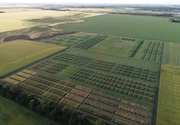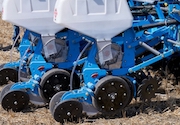| |
| |
 |
 |
| |
 |
|
Jan. 8, 2019 |
|
| |
 Manure application requires extra attention to prevent phosphorus losses, especially during winter and snow melt conditions. There are several practices that reduce the risk of P loss from manure, including avoiding winter application altogether and incorporating the manure.
» Read more...
Manure application requires extra attention to prevent phosphorus losses, especially during winter and snow melt conditions. There are several practices that reduce the risk of P loss from manure, including avoiding winter application altogether and incorporating the manure.
» Read more...
OMAFRA staff publish their corn seasonal summary for 2018 covering planting, pollination, grain fill, harvest and vomitoxin concerns. Despite growing season challenges, many growers reported yields above expectations.
» Read more...
According to a new study, previous applications of phosphorus fertilizers increase the effectiveness of subsequent applications. The study showed that when a lot of phosphorus has been applied over time, the penetration of phosphorus slows down and stops. When this happens producers only need to apply phosphorus where it’s missing instead of everywhere.
» Read more...
|
| |
|
| |
 Wheat is an important crop in rotation, but has declined in profitability and popularity relative to oilseeds and pulses in the Prairies. Because wheat is often responsive to management intensification, researchers in Saskatchewan are finding out if it pays to use an intensive management system to make wheat more than just a break-even crop in rotation.
» Learn more
Wheat is an important crop in rotation, but has declined in profitability and popularity relative to oilseeds and pulses in the Prairies. Because wheat is often responsive to management intensification, researchers in Saskatchewan are finding out if it pays to use an intensive management system to make wheat more than just a break-even crop in rotation.
» Learn more |
| |
 Irrigated corn has been a mainstay in southern Alberta, but as corn breeders push the maturity barriers lower, corn has become more appealing to dryland farmers. Researchers are piecing together row spacing, seeding rate, nitrogen fertility, tillage and crop rotations for dryland corn with impressive results.
» Learn more
Irrigated corn has been a mainstay in southern Alberta, but as corn breeders push the maturity barriers lower, corn has become more appealing to dryland farmers. Researchers are piecing together row spacing, seeding rate, nitrogen fertility, tillage and crop rotations for dryland corn with impressive results.
» Learn more |
| |
 |
| |
|
| |
|
|
| |
| |






